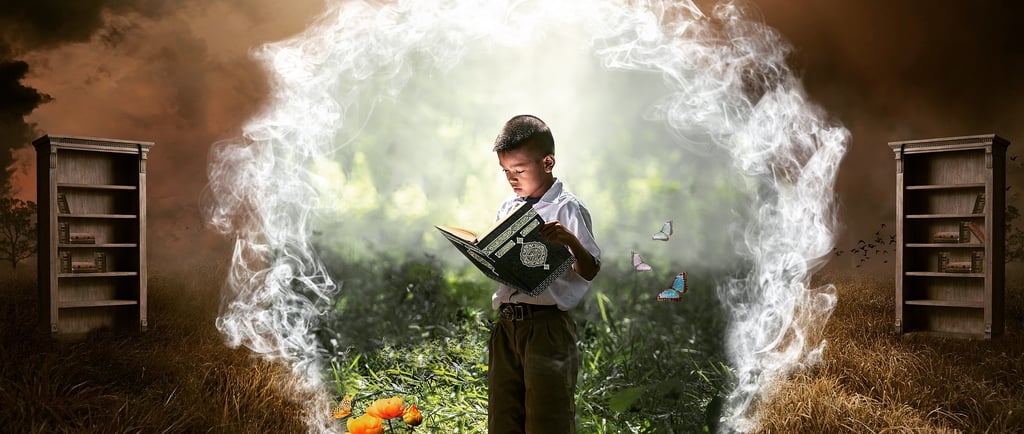🔎 Discovering the Many Ways Stories Speak: A Genre Exploration 🎭🐍Myths and Plays
📚 A Series of Stories that Introduce different Genres found in the Chapter – Appreciation of the Written Word in the Language Album✨Inviting children to notice how different genres express truth in their own way—some through rhythm and image like poetry 🎨📝, others through emotional journeys like fiction 🌌💭, or factual clarity like non-fiction 🌍📘. As children compare prose and poetry, biography and graphic novels, myth and play, they begin to uncover the invisible threads between how we read, how we write, and how we feel. 📖❤️ This genre invitation branches naturally into the rest of the chapter—toward Style and Voice, Reading Journals, Performance, and Literature Elements—asking: “What kind of truth do you like to tell?” and “Can I make a Play from my Graphic Novel?” 🗣️🪶
LANGUAGE STORIES
8/21/20253 min read


🎯 The purpose of this story is to help children see how human beings have always tried to explain the world—sometimes with facts and science, and other times through imagination, symbolism, and metaphor.
A long time ago, people saw the world around them — stars, animals, wind, fire, illness, love — and they asked: ✨ Why? ✨ How? ✨ What is the meaning behind all of this?
People always wondered why is the sun always rising from the same direction, or where the stars came from, or why snakes don’t have legs? 🤔💭
Before we had science books and experiments, people around the world told stories to explain the mysteries of nature. These stories are called myths.🧠 Clap it: 👏 Myth 👏 The word myth comes from the Greek mythos, meaning speech. A myth isn’t about facts — it’s about wondering. It’s ancient symbolic way of understanding something bigger.
🌍 Every culture has its own myths. In Japan, people once told a story about a giant catfish under the ground — when it moved its tail, the Earth would shake! 🐟🌏 In Norse mythology, thunder was said to be the sound of the god Thor riding his chariot across the sky. ⚡🛡️
These stories are not scientifically true, but they are emotionally true — they show what people who made them believed, felt, and wondered about the world. 🌬️💡But sometimes, instead of writing these stories down… People would tell them out loud, act them out, or pass them on through performance. 🎭 That’s where plays come in.🧠 Clap it: 👏 Play 👏
The word play (as in dramatic play) comes from Old English plegian, meaning to perform, or to exercise. Plays are written to be acted — with characters, dialogue, and movement. They aren’t meant to be read silently — they are meant to be seen and heard.
In Ancient Greece, plays were a big part of life. 🇬🇷🎭 People would gather in huge stone theatres, carved into hillsides, to watch stories performed live — stories filled with gods ⚡, monsters 🐉, heroes 🛡️, and deep questions about life and justice.
These plays were often based on myths — stories passed down about the gods of Mount Olympus, like Zeus, Athena, and Apollo, or the daring adventures of heroes like Odysseus, Heracles, and Persephone.👑🎭 These weren’t just entertainment — they were a way to explore truths, virtues, and the mystery of life.
In a play, you can become someone else — a god, a hero, an animal, a force of nature. 🌊🔥🌪️ Your words, your voice, your actions bring the story to life! 💬🦸♀️👣 🎟️ And even today, when you go to the theatre — plays are inspired by ancient myths or fiction stories, but using modern music, and costumes. 🎭🌟
And now… 📝 You can take a myth you’ve heard — and turn it into a play? Or you can choose one mystery of nature and write your own myth:
Why do 🐢 turtles have shell?
Why do 🌻 sunflowers follow the sun?
Why do 🌲 some trees stay green in winter?
Why do 🕸️ spiders spin webs?
Ask yourself: 💭 If that question had a story… what might it be? 💭 Who or what caused it? What lesson might it teach?
🎭 ✨ Follow-Up Explorations: From Myth to Play
Myth-Writing & Illustration Booklet
✏️🖍️
Invite children to choose a prompt and write their myth in story form, then illustrate one or more scenes.
📘 Create a class “Book of New Myths” with everyone’s contributions.
🗂️ This can be kept on the language shelf or displayed in the library corner.
Myth-to-Play
📜✍️ Prepare myths from all over the world and invite children to adapt them into short plays using a simple format:
Narrator lines
Character dialogue
Stage directions (optional)
💡 Offer a blank script template with spaces for narrator, characters, and simple actions.
Myth & Morals Discussion
📋💬 Can choose a myth fromany cultural tradition and reflect together:
What truth or lesson was in the story?
Was it joyful, serious, mysterious, funny?
🎟️ Going Out to a Play
🏛️🎭 Plan a Going Out experience to see a live performance — ideally one based on a myth, fable, or symbolic story.
Afterward, invite children to reflect:
What did the play make them feel or think?
How did the actors bring the story to life?
Could we try something like that?
This can spark deep inspiration for writing and staging their own plays, grounded in authentic experience. 🌟
With Montessori joy,
Vanina 😊

